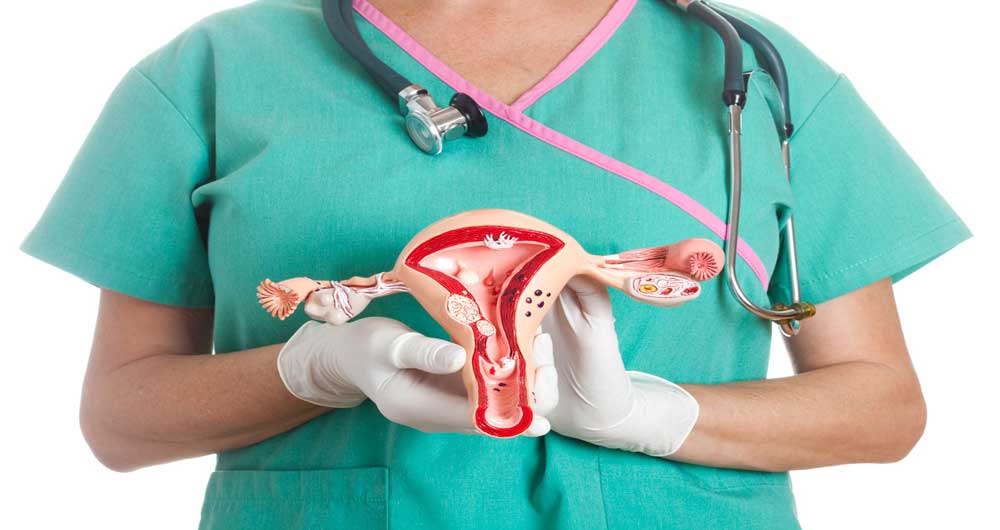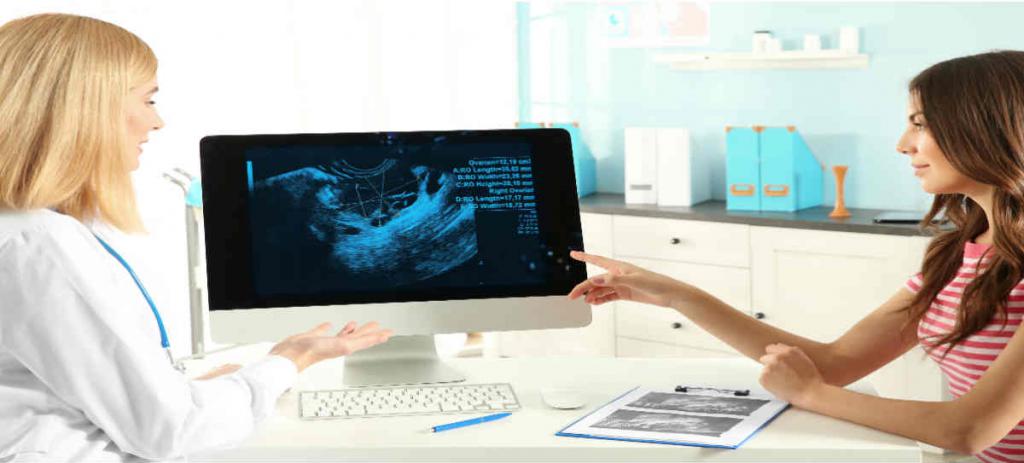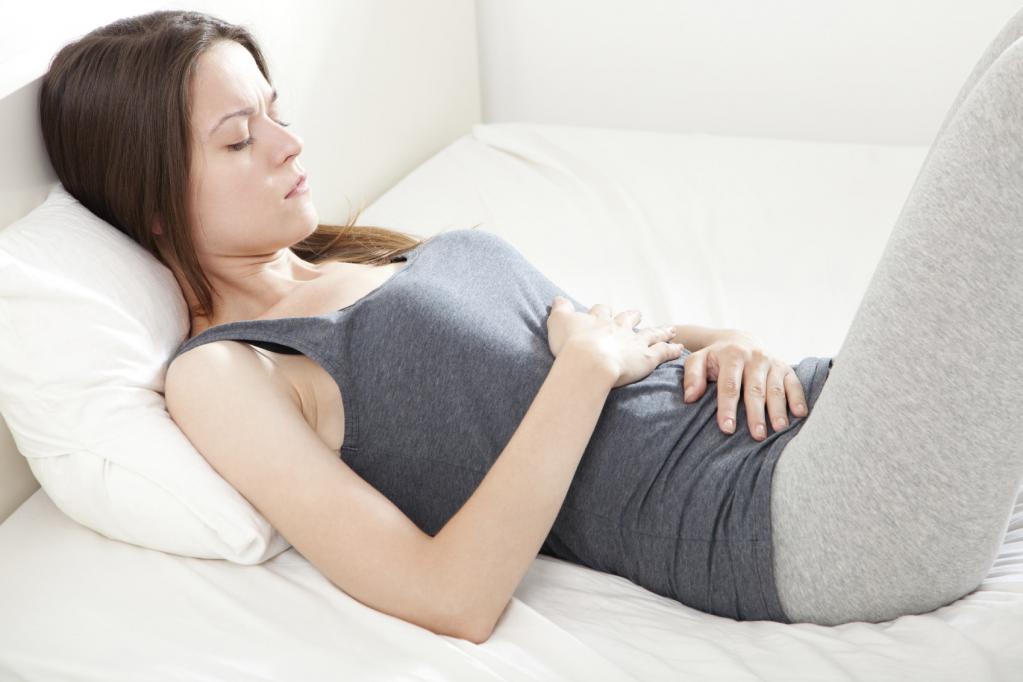Uterine fibroids - a benign tumor that occurs in the muscle layer of the uterus, the growth and development of which directly depends on the amount of estrogen in the woman’s body. There are several types of uterine fibroids. It tells about them below.
Subserous uterine fibroids
Large subserous uterine fibroids are a benign hormone-dependent formation in the muscle tissue of the uterus, which forms outside the organ and grows in the direction of the small pelvis. A neoplasm usually has a wide base and a thin leg (tumor supply channel) connecting it to the uterus.
Such myomatous tumors more often occur in reproductive age, grow slowly and proceed latently. The main danger of subserous fibroids is the twisting of the legs, in which there is necrosis of the tumor tissue.
Subserous myomatous nodules are multiple (small) or single.

Types of subserous uterine fibroids
Many do not know what is uterine fibroids, how to treat this ailment. Therapy depends on the type:
- Individuals have a capsular shell.
- Multiples are less common, but more painful. Because with growth they squeeze and disrupt the activity of neighboring structures. There are interstitial or intramural.
Intraventricular uterine fibroids
Intramural uterine fibroids of small sizes - a process in which there is a rebirth and replacement of healthy cells and blood vessels of muscle mass with fibrous and connective. Such a disease is quite common in women, the order of numbers is about 25%. If some time ago the disease was mainly found in middle-aged women, recently it has significantly “rejuvenated”. Intramural fibroids, in fact, is the body's response to various damaging factors. As a rule, the disease is diagnosed in the form of myomotous nodes, but often such growths do not have clear contours.
The causes of fibroids can be endocrine diseases, constant stress, smoking, as well as the presence of excess weight. However, the underlying reasons are as follows:
- late menopause;
- menopause;
- early menstruation;
- also other disorders of the menstrual cycle;
- heredity, the presence of the disease in close relatives - mothers, grandmothers;
- abortions
- various inflammatory processes of the genital area.

Submucous
Multiple submucous uterine fibroids is a serious disease and occurs in severe form with pronounced symptoms. It is a benign tumor that is located in the uterus and occurs due to myometrial cells. In most cases, the disease does not occur, as it proceeds without any symptoms. When diagnosing the disease, the patient manifests increasing anemia, there are pains in the abdomen during menstruation. At this moment, the girl cannot bear her child or become pregnant.
To identify this type of uterine fibroids, ultrasound and pelvic angiography are used. The method of treatment of the disease depends on the characteristics of its course. Most often, this disease appears in girls of reproductive age: aged 33 to 40 years. Recently, it has increasingly become apparent in women aged 19 to 26 years. With the onset of menopause, fibroids stop developing.
Doctors managed to prove that there is a close relationship between the disease and infertility in girls. Every fourth woman with infertility has a small uterine fibroid.

Interstitial
This is a benign tumor that develops as a result of an imbalance of sex hormones in women. It begins to grow in the muscle tissue of the uterus. Doctors call her fibromyoma. With the development of a benign tumor can reach large sizes, which in turn leads to the appearance of distinct symptoms.
The tumor can grow inside the walls of the uterus and at the same time not go beyond it. It can threaten a woman’s health. A benign tumor often takes the form of a node and reaches a size of 30 cm.
The disease may consist of one or more tumors. Most often appears in girls of childbearing age. As a result of exposure to a benign tumor, a woman can become infertile. Doctors were able to well study this type of tumor. As a result of the appearance of myoma nodes, in 50 cases out of 100 a benign tumor of this type appears. Even in young girls, a benign tumor can begin to develop, so the disease can manifest itself at any age.
Most often, the main cause of the appearance of this type of benign tumor is the effect of estrogen.

Causes
Currently, the causes of the appearance of uterine fibroids by scientists have not been determined for certain, but it has been definitely established that the disease is hormone-dependent. This means that estrogen and progesterone affect the disease. In each case, an anamnesis is collected, health and heredity are studied.
Today, experts identify several main causes of the disease:
- abortions
- delayed menstruation in adolescence;
- absence of childbirth by 30 years;
- various gynecological diseases;
- heredity and predisposition to the disease;
- stress;
- lack of an active lifestyle;
- the presence of excess weight;
- incorrect contraceptives.
Of the main reasons, abortion and the absence of childbirth by 30 years are distinguished. Scientists have noted that the appropriate age for the birth of a child is 22 years. To these reasons, it is also necessary to add untreated gynecological diseases, as well as the absence of breastfeeding. In addition, these reasons are considered by doctors to be extremely dangerous, as they can lead to surgery to remove the uterus.
Particular attention should be paid to menstruation with uterine fibroids. In this case, they will be plentiful, painful and frequent. But sometimes they can be absent for several months.
In no case should not underestimate the sluggish gynecological diseases that have an unexpressed form. That is why it is important to undergo a regular examination by a gynecologist and not start a disease.
Various pathologies of the cardiovascular system can also cause the disease, therefore young women need to monitor their health: avoid significant overweight, lead an active lifestyle and, if possible, avoid constant stress.
It is possible to quickly determine the type of uterine fibroids on ultrasound. And only after that proceed with surgical intervention.

Operation
If conservative therapy does not produce the desired effect, only surgery remains. Fibroids are removed by surgery. Any operation is always associated with risks for the girl, since even after a successful procedure complications can occur unexpectedly.
To remove nodes, various surgical methods of treatment are most often used. These include lane surgery, laparoscopy and laparotomy.
Abdominal surgery
If other methods of surgical treatment are ineffective, a cavity operation of uterine fibroids is used. Doctors try to use this method of surgery in rare cases, as it leads to serious complications. As a result, doctors are trying to apply other surgical treatments. After the abdominal surgery, the girl needs time for rehabilitation, so she is left in the hospital for some time. The essence of this operation is to cut the abdominal wall to remove nodes.
Laparotomy
This method of surgical intervention consists in the removal of formations. To do this, the surgeon makes a small incision on the abdominal wall. This method of surgery is rarely used in surgery, as there are other, more effective surgical methods of treatment.
Uterine Artery Embolization
Uterine artery embolization (EMA) is an effective current method for treating uterine fibroids (benign tumor). The method is considered a dilemma of hysterectomy (removal of the uterus), laparoscopic and hysteroscopic elimination of subperitoneal or submucosal myomatosis. The essence of EMA is to block the blood flow that feeds the myomatous areas. Due to this, the tumor gradually disappears, as a result of which the symptoms of the disease pass over time. EMA implies arterial thromboembolism by introducing specialized ingredients, and a tube with embolization using the material is inserted into the patient’s femoral artery. It reaches the uterine artery and blocks the bleeding in it.
Unlike the surgical method of treatment, EMA is much easier to tolerate by the patient, since there is almost no blood loss, and there is no need to introduce anesthesia. If there are no contraindications to EMA, in this case, the doctor will offer the patient to treat uterine fibroids in another way.
Embolization of the uterine arteries is a process for which preparation should be carried out by a specific method: the intake of antibacterial and antianerobic substances. The course of treatment is not less than 5 days. With pathology of the thyroid gland, restorative therapy is implied, only after that the uterine arteries are embolized.

FUS-ablation of uterine fibroids
Many are interested in the question of what is uterine fibroids, and how to treat it with the help of FUS-ablation. This is one of the non-invasive ways to get rid of the disease. The modern method, which is the evaporation of fibroids through ultrasound. The procedure is incredibly effective because its use is possible even with indications for a hysterectomy.
When fibroids are multiple in nature, not all nodes are determined by external examination. As a result, the disease progresses and is detected even with several large myomatous nodes. Previously, they were only removed surgically. However, such operations have significant risks of complications:
- commissures;
- hernias;
- sepsis, and so on.
FUZ ablation avoids this.
Benefits and contraindications
The advantages of the FUS ablation method are as follows:
- There are no incisions of the peritoneum and blood loss.
- There are no sutures on the uterus.
- Well tolerated.
- Constant monitoring of an MRI tomograph.
- General anesthesia is not needed. With a low pain threshold, fear offers local anesthesia.
- You can delete multiple nodes at once.
- The patient is conscious, so the procedure can always be stopped on time.
- The operation is outpatient, after some time you can go home.
- There are practically no relapses.
Contraindications:
- pregnancy;
- cardiovascular pathology;
- intrauterine device, metal implants, pacemaker;
- adhesions in the pelvis;
- a history of abdominoplasty;
- leg from fibroids;
- large area of the tumor;
- nodes less than 150 mm;
- over five nodes;
- intramural myoma;
- over 110 kg of weight and waist more than 110 cm;
- claustrophobia or panic attack.

Bubnovsky exercises
These exercises are widely used for uterine fibroids.
- Lift the pelvis.
This exercise is performed while lying on your back. Hands should be extended along the body. On inspiration, you need to enter the half-bridge pose. On exhalation, return to the starting position. The exercise is quite easy, it must be done about 25-30 times.
- Relaxation.
You need to get on all fours and try to relax. A very simple and useful exercise.
- Arching of the back.
The starting position is the same as in the previous exercise. Then, on exhalation, you need to bend your back up, and on inhalation, it bends down. Repeat 20 times. Exercise is recommended to be done with extreme caution, all movements should be careful so as not to get injured.
- Pulling step.
Starting position on all fours. Being in it, you need to bend the left leg in the knee joint and sit on it, while pulling the right leg back. The left leg should be tried to be pulled forward as much as possible, forcing itself to sink lower. Exercise to perform on inhalation. Repeat 20 times.
- Stretching the back.
Get on all fours again . It is necessary to bend your arms at the elbows and as you exhale lower the body to the ground, then straighten your arms and pull the pelvis back. To get the desired result, do 6 repetitions.
Often used alternative treatment of uterine fibroids. Reviews about it are rather mixed, therefore a consultation with a doctor is required. Potato juice, flax seeds, tincture of motherwort and other means effective for this disease should be agreed with the doctor.